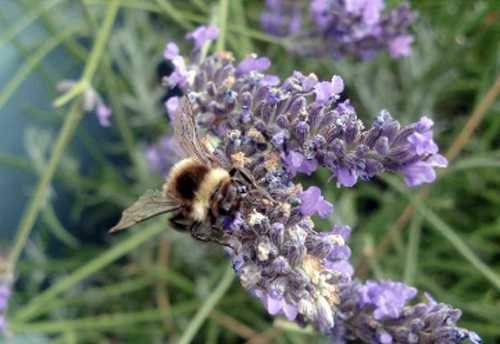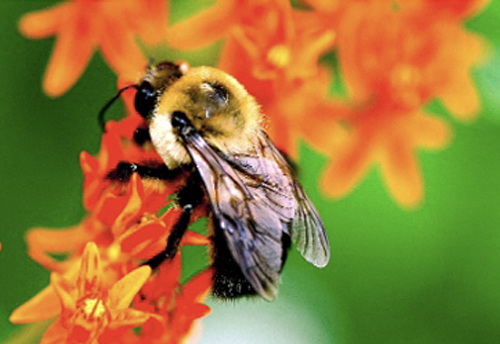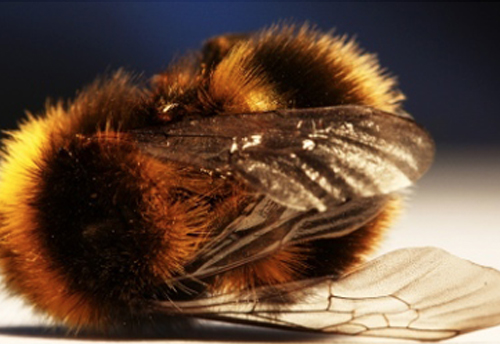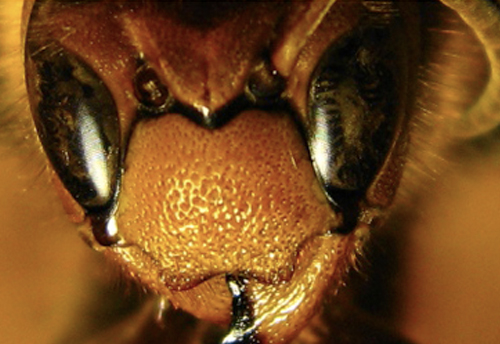“Beekeepers regularly disturb the hives, crushing some bees in the process. Beekeepers will replace the bees’ honey with high-fructose corn syrup or cheap, refined sugar, and may kill off the colonies to avoid maintaining the hives throughout the winter. Many beekeepers will clip the queen’s wings or use a “queen excluder” cage to keep the queen from relocating the hive; many will also kill the queen when the production of eggs visibly declines. They may use smoke to force the bees out of the hive so the honey can be harvested. Some beekeepers torch the entire colony when winter arrives.
In a natural environment the queen honey bee, not the beekeeper, would choose the hive’s location and the number of eggs produced. The bees would gather nectar and pollen to feed their own communities. Do the bees themselves care that they have lost control over their lives? They probably do. Not only do bees have brains; they also use those brains to form abstract concepts and to reach consensus. Joan Dunayer has described how “scouts (all of whom are sisters) search for a cavity of suitable location, dryness, and size” when planning their colonies. “A honey bee scout may advertise one site over a period of days,” adds Dunayer, but “[i]f a sister’s find proves more desirable than her own, the honey bee stops advocating her original choice and starts dancing in favor of the superior site. She’s capable of changing her mind and her ‘vote.’”7
Bees have a complex central nervous system, and many have intensely keen senses of sight and smell, and intricate methods of communication and nest architecture. They obviously experience their lives, avoid harm, and seek out what appeals to them and sustains them.”
— Lee Hall
THREE REASONS NOT TO EAT HONEY
“Unique among all God’s creatures, only the honeybee improves the environment and preys not on any other species.” ~ Royden Brown
From the basil plant a strong hum sounds, soft wings vibrate the air, endlessly searching for nectar. To truly watch these amazing creatures plunder and absent-mindedly pollinate these tiny white flowers makes one wonder how such a small creature could make such a large difference in our lives.
Yet without the humble bee:
– The food on your table
– The flowers in your garden
– The clothes on your back
might just disappear.
Bees* pollinate nearly 80% of all fruit, vegetable and seed crops in the U.S. We may be able to spray noxious fertilizers and pesticides on plants to “rid” ourselves of some problems (and create new ones). But we have yet to create a chemical that can successfully pollinate large crops. Nonetheless, we have still created an agricultural system that is in danger of killing one of its strongest contributors, in the pursuit of easy pollination and honey.
*Although there are numerous species of bees that pollinate flowers/crops, this job has been disproportionately taken over by farmed honeybees.

We’ve been tricked into believing that honey is simply a byproduct of the essential pollination provided by farmed honeybees. Did you know though that the honeybee’s wild counterparts (such as bumblebees, carpenter and digger bees) are much better pollinators? They are also less likely than farmed honeybees to be affected by mites and Africanized bees. The issue is that these native bees can hibernate for up to 11 months out of the year and do not live in large colonies. Thus, they do not produce massive amounts of honey. Enter a $157 million dollar a year industry and three reasons you should stop eating honey today.
1. GIVE THE BEES A BREAK
While you may spread a heaping tablespoon of honey on your morning toast without thinking, creating each drop is no small feat. To make one pound of honey, a colony must visit over two million flowers, flying over 55,000 miles, at up to 15 miles per hour to do so. During a bee’s lifetime, she will only make approximately one teaspoon of honey, which is essential to the hive for times when nectar is scarce, such as during winter. At times there may be an excess in the hive, but this amount is difficult to determine and large-scale beekeepers often remove all or most of it and replace it with a sugar or corn syrup substitute. Can you imagine someone removing all the fruit juice from your house and replacing it with fruit-flavored soda? It may still give you energy, but eventually it will probably make you sick.
Another thing to think about while you sit by your beeswax candle and contemplate the lives of these little fellows is that bees must consume approximately eight pounds of honey to produce each pound of wax! And the more we take from them (bee pollen, royal jelly, propolis) the harder these creatures must work and the more bees are needed, which isn’t good news for a population that is dwindling.
When you see a jar of honey, you may think of the sweet cartoon hives depicted in childhood stories such as Winnie the Pooh. But most hives are now confined to large boxes (a completely foreign shape to bees) that are jostled and shipped around the country to pollinate crops and produce honey. This is stressful and confusing to the bees’ natural navigation systems. Along the way, bees are lost and killed, and may spread diseases from one infected hive to another. The practice of bee farming often limits the bees’ diet to monoculture crops (*hint hint* blueberry, clover, lavender honey), introduces large
amounts of pesticides into their systems and causes the farmed bees to crowd out the native wild pollinators that may have been otherwise present. Beekeepers (even small-scale backyard beekeepers) will also kill the queens if they feel the hive is in danger of swarming (fleeing their file cabinet shaped homes) or drones* that they deem unnecessary to honey production.
* The drones’ main function is to fertilize the queen when needed.

Honey is meant as a health food; a health food for bees. The more we interfere with their natural processes, both by relying on farmed bees as pollinators (rather then other native wild bees, insects or animals) and to feed our desires for “sweets,” the closer we’re coming to agricultural disaster.
2. THE CASE OF THE DISAPPEARING BEES
The question of what will happen if bees disappear may not be far from being answered. Over the past couple of years, stories about bees disappearing and Colony Collapse Disorder (CCD) have been popping up in the The New York Times, Star Tribune, Huffington Post, PBS, Discovery News and more. If nothing else wakes us up, perhaps the fact that the disappearance of bees has become front page news will. Scientists are rushing to discover what’s causing this problem before it’s too late and before we lose the important environmental link created by bees.
Thus far, there are three main theories/contributing factors:
Pesticides
Pennsylvania State University published a study in 2010 that found “unprecedented levels” of pesticides in honeybees and hives in the United States. (If it’s in the bees and hives, what do you think is in your honey?) Some of these chemicals are killing bees, and guess what? The EPA knows about it.
“The EPA identifies two specific neonicotinoids, imidacloprid and clothianidin, as highly toxic to bees. Both chemicals cause symptoms in bees such as memory loss, navigation disruption, paralysis and death. Both chemicals have been linked in dramatic honeybee deaths and subsequent suspensions of their use in France and Germany. Several European countries have already suspended them. Last year Slovenia and Italy also suspended their use for what they consider a significant risk to honeybee populations.”
This is old news; this story came out in 2009. But has anything changed here? Not as far as I can tell.
Mites and Viruses
With weakened immune systems (stress, inferior food sources, pesticides etc.) bees have become more susceptible to viruses, fungal infections and mites. Many of these invasive bugs are spread as hives are moved around the country or transferred from country to country.
While there are a number of treatments on the market for the mites, viruses, funguses and other pests that are attacking our colonies, none have solved the problem completely. These treatments can also introduce antibiotics, pesticides and other chemicals into the hives in an attempt to prevent or heal infection. If these chemicals (often on strips) are not removed from the hive after they lose
potency, they can in fact help the viruses or mites become resistant to treatment in the future.

Cell phones
This is one of the newest theories on CCD and may need further testing.
“According to a Swiss researcher who recently published a paper on the subject, the electromagnetic waves from mobile phones have a significant impact on the behavior of honeybees and could potentially be harming honeybees around the world.”
“To test the relationship between honeybees and buzzing cellphones, he placed phones inside bee hives and then monitored the bees’ reaction. He found that in the presence of actively communicating cellphones (those not in standby mode), bees produced the sounds known as “worker piping,” which tends to indicate disturbance in a bee colony.”
– ABC News
Cell phones, pesticides and viruses aside, commercial bee farming – whether organic (where bee deaths are fewer, but still occur) or conventional – does not provide bees with the opportunity to live out their normal life cycle. No matter how small the animal, farming is farming. Whether you choose to buy backyard honey or a large brand, eating honey and using other bee products encourages using bees for profit.
Still have a hankering for some honey? Well the next fact might change just that.
3. THE STORY OF HONEY PRODUCTION
There are other insect-produced substances (such as shellac) and products derived from parts of insects (cochineal or carmine) that may be used in food, but these are not considered food in and of themselves. Some insects are also eaten as food, but honey remains the one product “created by” insects that is actually marketed as a food.
This is the true story of how this “healthy sweetener” is produced:
• The bees search for a source of nectar.
• When they find a suitable flower they dig in and swallow the nectar into their ‘crop’ (like a stomach for honey).
Not too bad so far… But wait.
• The bees then chew the regurgitated nectar, mixing it with saliva to add enzymes.
• Then they swallow it again.
• Then they regurgitate it again.
• This process is repeated…many, many times.
If we could see this process in action, would we really want to slather this substance on our toast? While some people may shrug and say ‘so what?’, the fact is that honey is a mix of regurgitated food and spit.
Let me ask you this:
Is there any other food that you would willingly eat that has been swallowed, vomited, mixed with spit, re chewed, swallowed and then regurgitated again? I don’t care how sweet it is, or what the “health benefits” are, one of my rules for life is: Do not eat anything that came out of another animal’s stomach.

The lives of bees are complex: they feel pain, they dance to communicate and they view the world through Technicolor eyes. While they may not directly offer their help to us, we should be grateful for all they do willingly and ask no more.
I hope that next time you see a bee, you will watch more closely and show your appreciation for their work by planting a flower-rich garden and leaving the honey, wax and other bee products for those winged creatures that truly need them.
Even the smallest of creatures deserves the right to live their lives free from being part of a production line.
_____________________
By Alisa Rutherford-Fortunati, Gentle World